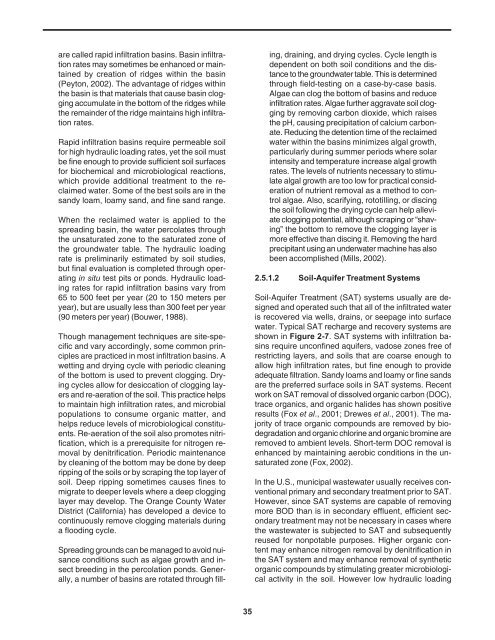o_19f3m1n7k170b14e9u0oqipgu4a.pdf
Create successful ePaper yourself
Turn your PDF publications into a flip-book with our unique Google optimized e-Paper software.
are called rapid infiltration basins. Basin infiltration<br />
rates may sometimes be enhanced or maintained<br />
by creation of ridges within the basin<br />
(Peyton, 2002). The advantage of ridges within<br />
the basin is that materials that cause basin clogging<br />
accumulate in the bottom of the ridges while<br />
the remainder of the ridge maintains high infiltration<br />
rates.<br />
Rapid infiltration basins require permeable soil<br />
for high hydraulic loading rates, yet the soil must<br />
be fine enough to provide sufficient soil surfaces<br />
for biochemical and microbiological reactions,<br />
which provide additional treatment to the reclaimed<br />
water. Some of the best soils are in the<br />
sandy loam, loamy sand, and fine sand range.<br />
When the reclaimed water is applied to the<br />
spreading basin, the water percolates through<br />
the unsaturated zone to the saturated zone of<br />
the groundwater table. The hydraulic loading<br />
rate is preliminarily estimated by soil studies,<br />
but final evaluation is completed through operating<br />
in situ test pits or ponds. Hydraulic loading<br />
rates for rapid infiltration basins vary from<br />
65 to 500 feet per year (20 to 150 meters per<br />
year), but are usually less than 300 feet per year<br />
(90 meters per year) (Bouwer, 1988).<br />
Though management techniques are site-specific<br />
and vary accordingly, some common principles<br />
are practiced in most infiltration basins. A<br />
wetting and drying cycle with periodic cleaning<br />
of the bottom is used to prevent clogging. Drying<br />
cycles allow for desiccation of clogging layers<br />
and re-aeration of the soil. This practice helps<br />
to maintain high infiltration rates, and microbial<br />
populations to consume organic matter, and<br />
helps reduce levels of microbiological constituents.<br />
Re-aeration of the soil also promotes nitrification,<br />
which is a prerequisite for nitrogen removal<br />
by denitrification. Periodic maintenance<br />
by cleaning of the bottom may be done by deep<br />
ripping of the soils or by scraping the top layer of<br />
soil. Deep ripping sometimes causes fines to<br />
migrate to deeper levels where a deep clogging<br />
layer may develop. The Orange County Water<br />
District (California) has developed a device to<br />
continuously remove clogging materials during<br />
a flooding cycle.<br />
Spreading grounds can be managed to avoid nuisance<br />
conditions such as algae growth and insect<br />
breeding in the percolation ponds. Generally,<br />
a number of basins are rotated through filling,<br />
draining, and drying cycles. Cycle length is<br />
dependent on both soil conditions and the distance<br />
to the groundwater table. This is determined<br />
through field-testing on a case-by-case basis.<br />
Algae can clog the bottom of basins and reduce<br />
infiltration rates. Algae further aggravate soil clogging<br />
by removing carbon dioxide, which raises<br />
the pH, causing precipitation of calcium carbonate.<br />
Reducing the detention time of the reclaimed<br />
water within the basins minimizes algal growth,<br />
particularly during summer periods where solar<br />
intensity and temperature increase algal growth<br />
rates. The levels of nutrients necessary to stimulate<br />
algal growth are too low for practical consideration<br />
of nutrient removal as a method to control<br />
algae. Also, scarifying, rototilling, or discing<br />
the soil following the drying cycle can help alleviate<br />
clogging potential, although scraping or “shaving”<br />
the bottom to remove the clogging layer is<br />
more effective than discing it. Removing the hard<br />
precipitant using an underwater machine has also<br />
been accomplished (Mills, 2002).<br />
2.5.1.2 Soil-Aquifer Treatment Systems<br />
Soil-Aquifer Treatment (SAT) systems usually are designed<br />
and operated such that all of the infiltrated water<br />
is recovered via wells, drains, or seepage into surface<br />
water. Typical SAT recharge and recovery systems are<br />
shown in Figure 2-7. SAT systems with infiltration basins<br />
require unconfined aquifers, vadose zones free of<br />
restricting layers, and soils that are coarse enough to<br />
allow high infiltration rates, but fine enough to provide<br />
adequate filtration. Sandy loams and loamy or fine sands<br />
are the preferred surface soils in SAT systems. Recent<br />
work on SAT removal of dissolved organic carbon (DOC),<br />
trace organics, and organic halides has shown positive<br />
results (Fox et al., 2001; Drewes et al., 2001). The majority<br />
of trace organic compounds are removed by biodegradation<br />
and organic chlorine and organic bromine are<br />
removed to ambient levels. Short-term DOC removal is<br />
enhanced by maintaining aerobic conditions in the unsaturated<br />
zone (Fox, 2002).<br />
In the U.S., municipal wastewater usually receives conventional<br />
primary and secondary treatment prior to SAT.<br />
However, since SAT systems are capable of removing<br />
more BOD than is in secondary effluent, efficient secondary<br />
treatment may not be necessary in cases where<br />
the wastewater is subjected to SAT and subsequently<br />
reused for nonpotable purposes. Higher organic content<br />
may enhance nitrogen removal by denitrification in<br />
the SAT system and may enhance removal of synthetic<br />
organic compounds by stimulating greater microbiological<br />
activity in the soil. However low hydraulic loading<br />
35



